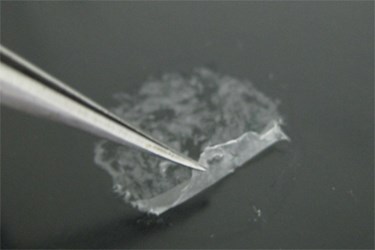Nanosheets Act Like Cling Wrap To Dress Burn Wounds
By Chuck Seegert, Ph.D.

Protecting patients from infection after a burn is critical, and in no place is it more challenging than areas with intricate anatomical contours like fingers and toes. Now, however, instead of using traditional dressings, researchers have developed ultrathin nanosheets that conform to those hard-to-protect areas and promise to provide protection from bacteria.
According to the Centers for Disease Control, someone is burned about every 30 minutes. Each burn must be protected from infection, which is usually accomplished by dressing the wound. For flat, broad areas of the body, existing dressings work pretty well, but the body is curved and has a number of asymmetric surfaces that can be hard to cover.
The new nanomaterial may overcome these challenges due to its extreme flexibility and stickiness.
“The nanosheets can adhere not only to flat surfaces, but also to uneven and irregular surfaces without adding any adhesives,” said Yosuke Okamura, Ph.D., in a recent press release from the American Chemical Society (ACS).
Dr. Okamura’s team from Tokai University uses poly(L-lactic acid) or PLLA to formulate the new nanosheets. The polymer is placed into a test tube and broken into small sheets by spinning rapidly. Pouring this liquid onto a surface then allows the nanosheets to settle, and eventually they overlap and join together producing a single nanosheet.
The researchers’ approach was initially tested on a number of irregularly shaped objects including a mouse’s fingers. The coating worked amazingly well and was able to cover even the smallest bumps and features on the rodent’s digits.
Testing continued by using the new nanosheets to dress burn wounds and then challenge them with Pseudomonas aeruginosa, a bacteria that commonly infects wounds and is often found in hospital-acquired infections. With a single coating, the dressing protected the wound for up to 3 days, and with the addition of another coating, it was capable of lasting for 6 days.
To put this into context, dressing changes in the clinic are usually done about every 3 days. By extending the time period to 6 days, the amount of time spent changing dressings can be drastically reduced.
Larger scale animal studies are currently planned by Dr. Okamura and his team, and eventually they hope to enter clinical trials and commercialize their technology.
Further details related to this advance will be presented at the 248th National Meeting & Exposition of the ACS.
Using nanotechnology to improve wound healing outcomes is an active area of research on many fronts. In a recent article published by Medical Device Online, a wound-healing nanogel with self-assembling proteins was described.
Image Credit: Yosuke Okamura
